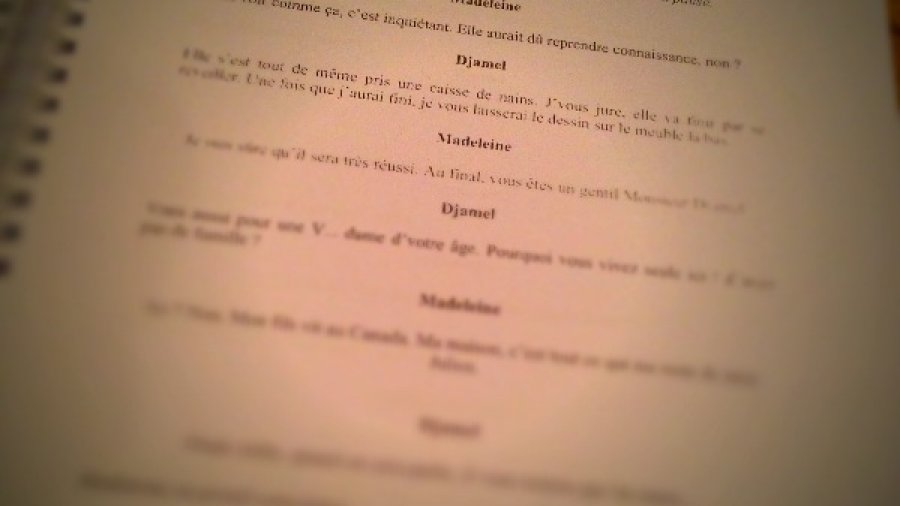
Present a scenario
Here’s one of the questions that comes up the most, with How to become a director, it is How to present a scenario ?
Before you respond, it is important to know what composes a scenario. The typo used is in general : Courier font size 12. But today other typos are accepted, such as : times new roman, always in size 12. Never send a screenplay manuscript under penalty of landing directly in the trash. Your final scenario will therefore be what is called the continuity conversed. To know the duration of your scenario the rule is simple : each page takes between 45 seconds and a minute.
The scenario consists of sequences, that is to say, of scenes.
The sequence defines:
– if the action happens indoors or outside
– a place
– a time
Let’s take an example of continuity conversed :
Sequence 1 : INT – BAR – NIGHT
Marc is standing at the bar. On the other side of the bar Manolo approach him a bottle of whisky to hand.
Manolo
I guess you reprendras a drop ?
Marc
I don’t know…
Manolo
It is the house that offers
Marc
No, this is not a good idea. Julia is waiting for me at home, I have to go there.
Marc stands up and walks in the door.
Scene 2 : EXT – BAR / STREET – NIGHT
Marc leaves the bar and disappears around the corner of the street.
The change sequence depends on the change of venue. In this example, the action is the same : the Mark leaves the bar. Yet it is divided into two sequences are clearly distinct. It is possible to keep the action in the same sequence, you induce in this case that the filming there will be no ” cut “. You can put the sequence in bold font size 14.
All the stage directions* (text that is not dialogue) are to be put in italics. First names or character names are also in bold and then the dialogues below. The whole thing is centered in the middle of the page.
CAUTION : The writer must share his way of writing, putting forward what it wants to show. There is nothing more complicated than reading a script. Consider that every line change is an implementation before. Do not lose sight of the fact that you direct the reader.
Example :
Sequence 3 : EXT – STREET – NIGHT
Marc up the street, he looks at his watch, the clock shows 1: 30. He starts running faster and faster.
While :
Sequence 3 : EXT – STREET – NIGHT
Marc up the street, he looks at his watch.
The clock shows 1: 30.
He starts running faster and faster.
You see the difference ? The rhythm is not the same. The reading changes. Think about it when you write.
Once you have written your entire scenario, you must print only on the front, and then all connect by thermocollé or simply spiral. In general, producers prefer the second solution as it allows for a reading and note-taking easier.
The séquencier of a scenario, that is what it is ?
Here’s a funny bird….I didn’t know in my early days that he had to go through this step before you write the scenario itself. So I, like many, is the total dead-end on this step. Well I took. If you decide to pass in addition, please be aware that you might lose in the dialogues and details.
In fact, the séquencier is the concatenation of all the sequences of your scenario, but a summary in a few lines.
In this way you will see if from one sequence to another are linked together in a logical way. It is necessary that the evolution of your story/ your characters are from one sequence to another in a very natural way.
Attention, do not go too much into details. It is necessary that one understands what you want to pass as an idea and not how you want to do. This will seem to you may be binding at the start, but you say that this method is extraordinary. And thanks to it you will go to the essential.
Take the example of the scenario at the beginning of this article. This is what it would look like the séquencier of these two sequences.
Sequence 1 : INT – BAR – NIGHT
Marc is at the bar, he refuses a drink and gets out because his wife is waiting for him.
Scene 2 : EXT – BAR / STREET – NIGHT
Marc disappears around the corner of the street
Sequence 3 : EXT – STREET – NIGHT
Marc is late, he starts running
If you can’t summarize your movie in a few lines is that it is not clear in your head, or you lose details.
But if you have followed step-by-step method of this site, you should not encounter this kind of problem (if you have not read the first articles or that you want to read, you can click in the archives). Now you know what you need to do to present a scenario.
* Stage directions are written by the author to the destination of the actors/ readers, giving indications of action, game or set the scene. It allows you to give information, in particular, on the behaviour, mood or the attire of a character.
You can return to the site map or read the article on the presentation of a scenario 2 : Move from one room to another by clicking on the links.
Good Luck,
Tom